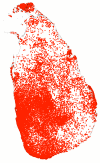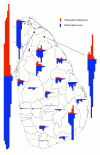Maps of the Sri Lanka malaria situation preceding the tsunami and key aspects to be considered in the emergency phase and beyond
- PMID: 15676073
- PMCID: PMC548668
- DOI: 10.1186/1475-2875-4-8
Maps of the Sri Lanka malaria situation preceding the tsunami and key aspects to be considered in the emergency phase and beyond
Abstract
Background: Following the tsunami, a detailed overview of the area specific transmission levels is essential in assessing the risk of malaria in Sri Lanka. Recent information on vector insecticide resistance, parasite drug resistance, and insights into the national policy for malaria diagnosis and treatment are important in assisting national and international agencies in their control efforts.
Methods: Monthly records over the period January 1995-October 2004 of confirmed malaria cases were used to perform an analysis of malaria distribution at district spatial resolution. Also, a focused review of published reports and routinely collected information was performed.
Results: The incidence of malaria was only 1 case per thousand population in the 10 months leading up to the disaster, in the districts with the highest transmission.
Conclusion: Although relocated people may be more exposed to mosquito bites, and their capacity to handle diseases affected, the environmental changes caused by the tsunami are unlikely to enhance breeding of the principal vector, and, given the present low parasite reservoir, the likelihood of a malaria outbreak is low. However, close monitoring of the situation is necessary, especially as December-February is normally the peak transmission season. Despite some losses, the Sri Lanka public health system is capable of dealing with the possible threat of a malaria outbreak after the tsunami. The influx of foreign medical assistance, drugs, and insecticides may interfere with malaria surveillance, and the long term malaria control strategy of Sri Lanka, if not in accordance with government policy.
Figures





References
-
- WHO Situation Report 4 January 2005 http://w3.whosea.org/EN/Section23/Section1108/Section1835/Section1862_83...
-
- WHO Situation Report 14 January 2005 http://w3.whosea.org/EN/Section23/Section1108/Section1835/Section1862_84...
-
- Tsunami Maps via FTP from IWMI http://www.iwmidsp.org/iwmi/info/tsunami.asp
-
- Konradsen F, Amerasinghe FP, Van der Hoek W, Amerasinghe PH. Malaria in Sri Lanka: Current knowledge on transmission and control. Colombo: International Water Management Institute; 2000.
Publication types
MeSH terms
Substances
LinkOut - more resources
Full Text Sources
Medical

